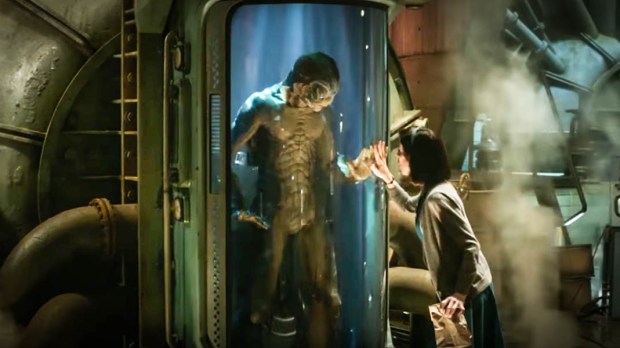So, what is the shape of water? That’s the question acclaimed director Guillermo del Toro was recently asked by a fan on Reddit. The answer he gave was short and simple. “The shape it needs to take,” del Toro said, “Like love. Both are gentle, malleable and yet, they break through every barrier … In the film, ‘The Asset’ is the shape of it.”
“The Asset” of which del Toro was speaking is the aquatic man-beast at the heart of his new film, The Shape of Water. In appearance, The Asset is something of a cross between the Creature from the Black Lagoon and Hellboy’s Abe Sapien. In temperament, he is the noble savage, a mostly gentle being free of modern man’s darker shadings. Well, until he’s really, really provoked, at least.
Before we get to meet The Asset, however, the film introduces us to Elisa Esposito (Sally Hawkins), a mute cleaning woman at the government-run research facility where The Asset is being held prisoner. As the movie begins, we see Sally slumbering peacefully in a small apartment filled to the ceiling with water, furniture floating delicately about her.
Are we in a dream or some alternate reality? Sort of. What we are watching is a fairy tale, the narrator assures us, one about love and the monster who tries to destroy it. Ah, so we are in a moral story then, as G.K. Chesterton describes a fairy tale, one that is “not only moral in the sense of being innocent, but moral in the sense of being didactic, moral in the sense of being moralizing.” And just what is The Shape of Water moralizing about? Well, let’s find out.
Once the alarm clock awakens Elisa from her dream of being enveloped in water (see del Toro’s statement above for the symbolism), she begins her nightly routine. This involves pleasuring herself during her bath (no one said this was a children’s fairy tale) and preparing hard-boiled eggs to share with her neighbor Giles (Richard Jenkins) while they watch old musicals. Elisa’s personal life, it seems, is one of constant fantasizing, be it through her dreams, her sexual activities, or her choice of entertainment. To hammer home the point, as Elisa leaves for work, we see that her apartment is located directly above a movie theater.
Perhaps Elisa’s constant dream state is somewhat understandable, though, as her reality is somewhat harsh and lonely. Her muteness only helps to reinforce her isolation. She has Giles, but being a closeted homosexual (it’s the early 60s), he can offer her nothing beyond a sympathetic shoulder. Her remaining friend, Zelda (Octavia Spencer), she sees only at work where they toil through the night cleaning up after some rather unhygienic scientists.
Elisa’s reality and fantasies collide once she meets The Asset. Bonding over boiled eggs and music, the two begin to develop feelings for one another despite the fact that she’s human and he’s a gill man with nictitating membranes where his eyelids should be. Unfortunately for The Asset, Elisa is the only one who sees him as more than a monster. Strickland (Michael Shannon), the man in charge, believes The Asset to be nothing more than a mindless animal, one to be routinely beaten bloody as Strickland sees fit.
This is where some of The Shape of Water’s moralizing shows up. Set in the days of the Civil Rights movement, it’s hard not to notice that all of the good guys in the film are repressed minorities in some way, while all the bad guys are militaristic white men who misquote the Bible and carry big sticks. Strickland, in particular, is as broad a villain as they come. He abuses the innocent Asset just because the creature is different, dishonors his wife (and Elisa) when he sexually harasses the latter, and basically tells Zelda that God is a white man. The only thing Strickland is missing is a mustache to twirl.
The movie is more successful is in its depiction of the budding romance between Sally and The Asset. Del Toro films the scenes between the two with all the poetry he can muster, which, if you’re familiar with his filmography, is quite a bit. Even the inevitable physical consummation of the relationship, which should be off-putting, is depicted in a tasteful, lyrical fashion. It’s basically the beautiful swimming scene from The Creature from the Black Lagoon without the need for metaphor.
There are even some religious elements to the relationship, if one cares to look for them. Like most disgruntled lapsed Catholics, del Toro can’t really escape the teachings of his upbringing. More than once, his screenplay refers to The Asset as a god (he even has healing powers), and it is only in this god that Sally finds the answer to her heart’s deepest longing. The reality of The Asset, whom del Toro stated is “love,” who is “the shape of water,” replaces all of the imaginary fantasies Sally has been clinging too.
One has to wonder if del Toro even realizes he puts these kinds of things into his movies. Purposefully or not, though, they continue to show up, and they help make this adult (we mean it) fairy tale one of the most poetic and heartfelt movies of the year.

